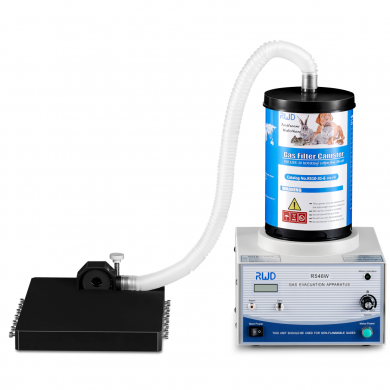
Anesthesia Cone Masks
$19.00
Select options

Feline / Canine Masks
$29.00
Select options

MRI Compatible Active Anesthesia System
$949.00
Add to cart

MRI Compatible Masks Package
$203.00 – $286.00
Select options

Non Rebreathing Circuit
$75.00 – $90.00
Select options

Standard Passive Anesthesia System: 5 Channel Cone Mask
$5,400.00
Add to cart
Check our Anesthesia Masks
Anesthetic face masks are usually cone-shaped, and their sizes vary depending on the size of the subject. Face masks selected should be of a snug fit and should not obstruct the mouth or nose of the subject. Small, transparent masks fitted with flexible rubber diaphragms prove to be useful in a large array of animals and birds. The snug fit ensures that the masks are not too large for the animal and prevent the re-inhalation of expired gases. Face masks that incorporate waste anesthetic gas removal (Hunter et al., 1984) are ideal for preventing exposure-related hazards to the personnel.
Breathing systems are used for the delivery of oxygen, removal of exhaled carbon dioxide, and ensuring sufficient anesthetic gases, meeting the animal’s requirements, are delivered. Although anesthetic chambers are useful when used for small animals that are difficult to restrain, they require the removal of the subject from the chamber to allow for surgical procedures. Thus, breathing systems make for a better option as opposed to the anesthetic chambers.
The open face mask is the most widely used breathing system, which provides a simple and convenient way of delivering anesthetic agents to the subject. For these systems, the gas flow should be sufficiently high to avoid rebreathing of exhaled gases and the dilution of anesthetic gases. The expired gases pass around the edges of the face mask.
The open breathing system is one of the most widely used systems in the anesthetization of laboratory animals. While using these systems, appropriate measures should be taken to derive their full potential. The gas flow used should be sufficiently high to avoid rebreathing of expired gases and the dilution of the anesthetic agents.
While using face masks, it should be ensured that the masks fit snuggly around the muzzle of the subject without obstructing the nose or mouth. The size of the face masks is also a critical factor in ensuring that re-inhalation of expired gases does not take place. When using face masks, especially in small subjects, preventive measures to avoid displacement of the masks must be taken. Face masks should be thoroughly cleaned using warm soapy water or when possible sterilized using ethylene oxide.
Although a simple system, the open breathing system has its drawbacks. The system requires sufficiently high gas flow rates, especially in large animals. Further, removal of waste anesthetic gases is difficult in the open breathing system due to the use of face masks. The system also makes assisted ventilation difficult to administer should the need arise; the experimenter has to rely on manual chest compressions.
Though concentric face masks are in use for small animals and assist with the removal of the WAGs, these do not function similarly in concept to the Bain coaxial breathing system. Thus, they require gas flow appropriate to an open breathing system. However, current concentric face masks offer too high gas extraction rates.
Accommodating these rates could result in a significant economic loss concerning the wastage of anesthetic gases. Low flow face masks could serve as an alternative to these masks.
Let’s work together!
Have questions? Ask anything!